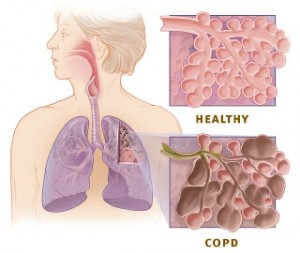Chronic obstructive pulmonary lung disease (COPD) is a lung disease in which the lungs are damaged, making it hard to breathe. In COPD, the airways- the tubes that carry air in and out of your lungs are partly obstructed, making it difficult to get air in and out.
The airways branch out like an upside-down tree, and at the end of each branch are many small, balloon-like air sacs called alveoli (al-VEE-uhl-EYE). In healthy people, each airway is clear and open. The air sacs are small and dainty, and both the airways and air sacs are elastic and springy. When you breathe in, each air sac fills up with air like a small balloon; when you breathe out, the balloon deflates and the air goes out. In COPD, the airways and air sacs lose their shape and become floppy. Less air gets in and less air goes out because:
- The airways and air sacs lose their elasticity (like an old rubber band).
- The walls between many of the air sacs are destroyed.
- The walls of the airways become thick and inflamed (swollen).
- Cells in the airways make more mucus (sputum) than usual, which tends to clog the airways.
 The illustration shows the respiratory system and cross-sections of healthy alveoli and alveoli with COPD.
The illustration shows the respiratory system and cross-sections of healthy alveoli and alveoli with COPD.
COPD develops slowly, and it may be many years before you notice symptoms like feeling short of breath. Most of the time, COPD is diagnosed in middle-aged or older people.
COPD is a major cause of death and illness, and it is the fourth leading cause of death in the United States and throughout the world.
There is no cure for COPD. The damage to your airways and lungs cannot be reversed, but there are things you can do to feel better and slow the damage.
In the United States, chronic obstructive pulmonary disease (COPD) includes:
- Emphysema
- Chronic bronchitis
In the emphysema type of COPD, the walls between many of the air sacs are destroyed, leading to a few large air sacs instead of many tiny ones. Consequently, the lung looks like a sponge with many large holes in it, instead of a sponge with very tiny holes. Poor exchange of the oxygen and carbon dioxide causes shortness of breath.
In chronic bronchitis, the airways have become inflamed and thickened, and there is an increase in the number and size of mucus-producing cells. This results in excessive mucus production, which in turn contributes to cough and difficulty getting air in and out of the lungs.
Most people with COPD have both chronic bronchitis and emphysema.
Source: nhlbi.nih.gov